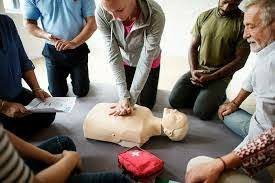Why First Aid Training is Essential for Workplace Safety and Emergency Preparedness
In today’s fast-paced work environment, safety should be a top priority for every business owner and HR manager. First Aid training and CPR certification aren't merely optional; they are essential components in creating a safe workplace. This comprehensive guide covers the importance of First Aid training, its benefits to employee safety, and the compliance requirements businesses must meet.
The Importance of First Aid Training
First Aid training equips employees with the skills needed to respond effectively to medical emergencies, from minor injuries to life-threatening situations. By investing in First Aid training, businesses can:
- Enhance Workplace Safety: Employees trained in First Aid can swiftly respond to emergencies, reducing the severity of injuries and saving lives.
- Increase Employee Confidence: Knowledge of emergency procedures empowers employees, fostering a sense of security that leads to a productive work environment.
- Foster a Safety Culture: Regular training instills a culture of safety, making employees more aware of potential hazards.
Key First Aid Skills Every Workplace Should Prioritize
When undergoing First Aid training, it is crucial to cover essential skills that can be applied in various emergency situations:
- Basic First Aid Techniques: Skills such as bandaging wounds, treating burns, and managing sprains are foundational.
- CPR Techniques: Knowing how to perform CPR can be the difference between life and death during cardiac emergencies.
- Choking Response: Training on how to assist someone who is choking is vital, especially in environments where food is present.
Understanding CPR: Life-Saving Techniques Every Employee Should Know
Cardiopulmonary resuscitation (CPR) is a critical skill that everyone should master. Training in CPR includes:
- Recognizing Cardiac Arrest: The ability to identify the signs of cardiac arrest quickly is essential.
- Performing Chest Compressions: Learn the correct techniques and depth for effective chest compressions.
- Using an AED: Automatic External Defibrillators are commonly available in workplaces; knowing how to operate them can save lives.
Regulatory Compliance and Workplace First Aid Requirements
Every workplace has legal obligations regarding employee safety. Staying compliant with health and safety regulations includes:
- Understanding Workplace First Aid Requirements: Regulations often dictate the number of trained First Aiders required based on staff size.
- Ensuring Regular Training: To maintain compliance, businesses should ensure employees undergo First Aid certification regularly.
- Documentation: Keeping records of training sessions and certifications helps in demonstrating compliance during audits.
Benefits of First Aid Certification for Businesses and Employees
First Aid certification is mutually beneficial for both employees and employers:
- Reduced Liability: A certified workplace can significantly reduce its liability during emergencies.
- Improved Morale: Employees feel safer knowing that their co-workers can provide help, thereby boosting workplace morale.
- Enhanced Performance: Trained employees are more efficient in their roles, as they can respond effectively to emergencies without panicking.
Emergency First Aid Procedures: Step-by-Step Guidelines
In the case of an emergency, having clear First Aid procedures in place is crucial. These may include:
- Assessing the Situation: Determine whether it’s safe to help the injured person.
- Calling for Help: If necessary, dial emergency services to ensure professional assistance is on the way.
- Administering First Aid: Apply the relevant First Aid procedures while keeping the injured person calm.
Choosing the Right First Aid Course: Online vs. In-Person Training
Selecting a First Aid course that fits your workplace requirements is crucial. Consider the following:
- Flexibility of Online Courses: Online First Aid courses can be a convenient option for businesses with remote employees.
- Hands-On Practice: In-person training is invaluable for practicing skills such as CPR and the use of an AED.
- Certification Recognition: Ensure that the course provides a recognized certification that meets regulatory requirements.
Final Call to Action: Enroll Your Team in a Certified First Aid & CPR Training Course Today!
Don’t wait for an emergency to highlight the importance of First Aid training. Empower your employees by equipping them with essential First Aid and CPR skills. Enroll in our comprehensive First Aid and CPR training course today!
For questions or to learn more about our training offerings, contact us at [email protected].



 349,500 Offered Certificates
349,500 Offered Certificates
 24/7 Online Training
24/7 Online Training
 Money Back Guarantee
Money Back Guarantee
 Fully Accredited Courses
Fully Accredited Courses
